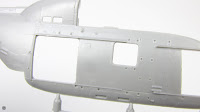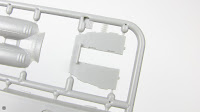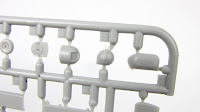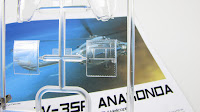PZL W-3SP Anakonda

Polish PZL Anakonda helicopter had so far no luck when it comes to decent 1:72 scale models. Will Answer's new kit change that? Let's find out.
Answer
The manufacturer of the kit in question is a relatively young player in the field of 1:72 scale plastic models – it’s first miniature developed in this scale, PZL W-3A Sokół (two editions released so far), debuted barely a few months ago. Now Answer’s range was expanded by several boxes with Anaconda helo (derivative of Sokół). Two sets take up the theme of Polish Navy aviation.
Third one, which we will look at closer, comes with the machine from Polish special forces unit GROM.
The box
The kit, subtitled “Special Forces Unit GROM Helicopter” (catalogue number AA72023), arrives in a top-opening box featuring Seweryn Fleischer's artwork on the lid.
One side of the packaging shows the forthcoming models, as well as those released alongside the reviewed edition. Although something didn't quite work out here, and instead of a third box with the Anakonda, we learn about the existence of the kit we are currently looking at.
The box is filled with quite a lot of plastic parts in light grey, some transparencies, two photo-etched detail sheets, a lone 3D printed piece, decal sheet and assembly manual.
Partly it’s a repetition of the sprues from previously released PZL Sokół kits, which have however not yet come into my hands.
Plastic
Let's begin a more detailed overview by looking on the sprue marked with “A” (but only in the instruction, not on the plastic itself), which contains the main fuselage parts.
Anakonda belongs to the so-called "short-run" kits and, as it turns out after a closer inspection of the fuselage halves, not necessarily the best ones. Raised surface details, of which there are quite a few, are disappointingly unclear, with a rather soft edges.
Where they are that is, because, for example, the fuselage reinforcement strips tend to fade away. As do the panel lines, which also disappear in the least expected places – see the fuselage-tail boom section.
It's a shame, because it's clear that a solid portion of surface details was included in the design, whereas the result looks very poor.
The fuselage underside, prepared as a separate part, doesn't look quite as bad, although the aforementioned flaws are present here too (e.g. fading stripes in the central part of the piece).
Sprue “B” makes a slightly better impression.
Admittedly, some of the surface details are too lightly marked for my taste, but they are there – and even in their entirety.
The cabin floor is rather perplexing – absolutely no details in the transport section. The ceiling, on the other hand, has some reproduced.
Sprue “C” is dominated by the main and tail rotor components.
The blades of the former were designed with a characteristic sag.
“C” also contains one of the instrument panels, the unnecessary one.
“D” sprue is a collection of miscellaneous parts, sprinkled with a portion of flash.
Few pieces for the cabin interior, exhausts and some optoelectronic pods.
One will find here also the landing gear wheels (or rather the front ones and rear tyres), which are completely devoid of tread, which is not at all surprising. Worse is the fact, that one side of the tyres (each is made up of two parts) has apparent roundness problem.
Sprue “E” is a collection of minor details, that I won't even attempt to list.
In addition to the mild flash, one can find here some sink marks, fortunately in simple parts, where dealing with it shouldn’t be a problem.
There is another small piece of “E” sprue in the box, but it’s not the same “E” sprue as shown earlier (!). Well, this will certainly make the search for parts much easier.
Sprue “H” features new elements intended for the Anakonda.
Here are the distinctive for this variant floats and part for the fuselage rear.
But also the highest amount of flash.
Notice the rather poorly looking instrument panel, for which no decal has been provided – good luck with the paint job!
In contrast, its cover with a really thin edge looks quite nice.
Transparencies
“Glass” was probably the most criticised part of the previously released 1:72 PZL Sokół. This edition comes with addition of a small frame with a slightly different glazing of the Anakonda's nose section.
Windows can hardly be called exemplary. Despite a pretty good first impression, a closer look reveals some rather unpleasant irregularities in the internal structure.
There's also the famous flaw in the transport compartment door – although we won't use that part this time, and the alternative version looks a little bit better.
A number of minor details, such as searchlight and the tiny glazing for the optoelectronic pod, can also be found on the transparent sprues.
Surprisingly, despite the visible irregularities in the plastic, the transparency of the “glass” is not the worst.
Obviously, the front doors with bulging windows are the worst in this respect, but this comes as no surprise.
Pity that the manufacturer didn't provide the self-adhesive masks. I understand that this is an additional complication and cost, but for such a heavily glazed machine it would have been most welcome.
3D print
The real conundrum is the included resin part, prepared with the 3D printing technology. The level of detail, let alone the print quality, doesn't justify this production method. Lack of space on the sprues? A detail overlooked during design? I really don't know.
Whatever the case, the outcome looks pretty poor, and on top of that – the resin is still sticky (at least in my case).
PE details
In contrast, the included photo-etched sheets look quite good. The larger one (with engine section meshes and crew belts – also for the seats in the transport compartment) is a repeat from the PZL Sokół kit, while the smaller one contains few elements only for the PZL Anakonda.
On none of these, one will find an on-board instrument panel, although some of the ceiling-mounted switch panels have been prepared in this way.
Modellers who are not particularly fond of working with metal elements will be probably upset by the fact, that it is impossible to make the model without at least some use of PE parts. For example, the plastic covers of the engine compartment have holes for photo-etched grids, and this is the only solution provided for its in the model.
Decals
Markings sheet was made with the help of the Polish Techmod company and looks quite good.
The print is clear, without any noticeable flaws, and the colours (although few) are saturated and uniform.
Absolutely baffling is the lack of an instrument panel prepared at least in this form. Just a small thing, and it would have definitely increased the attractiveness of a rather flimsy plastic part.
Assembly manual
The kit's assembly and painting instructions come in the form of folded, unstapled sheets of paper.
However, the black-and-white assembly drawings are pretty neat and quite clearly show what needs to be glued where.
I would like to draw potential builders' attention to the right door of the transport compartment. The instruction indicate the use of part no. 166 with a uniform window, and this is how it’s depicted on the colour profiles. However, this is contradicted by the photos of the real machines (and 'boxart' too) at the end of the manual.
The painting of the external surfaces and the positioning of decals are shown in the aforementioned colour views.
These are supplemented by a rather meagre tables with suggested paints – only from Hataka, Bilmodels and, to some extent, AK-Interactive.
The lack of any informations regarding interior colours is just ridiculous.
Paint schemes
Variety of paint schemes is not the thing one will find in the new Answer’s kit. Colour profiles from the earlier photos show all the options available. Yes, there are only two and both depict the same machine with side number 510. Rather unimpressive.
Summary
Well, if one expected a world-class large-production model – will be disappointed. Sorely. New Anakonda is a short-run kit through and through. Unfortunately not the best one.
The fuselage halves are the worst, showing the wasted potential of the project most clearly. Especially as it supposedly didn’t look so bad in the PZL Sokół kit, which may indicate manufacturer’s difficulties in maintaining a steady production quality. Problems with the injection moulding process also seem to be indicated by the widely criticised transparencies – with smooth surface, but some internal flaws of the plastic. Whether the Answer will address this (if possible), remains to be seen.
The kit's quality is also negatively affected by some incomprehensible, at least for me, decisions made by the publisher. The lack of a sensible instrument panel or the complete omission of the interior colours in the manual are things that, in my opinion, shouldn't occur in a newly released kit.
Is it worth you time? As always – judge for yourselves. I’m nevertheless kind of tempted.














































































































































